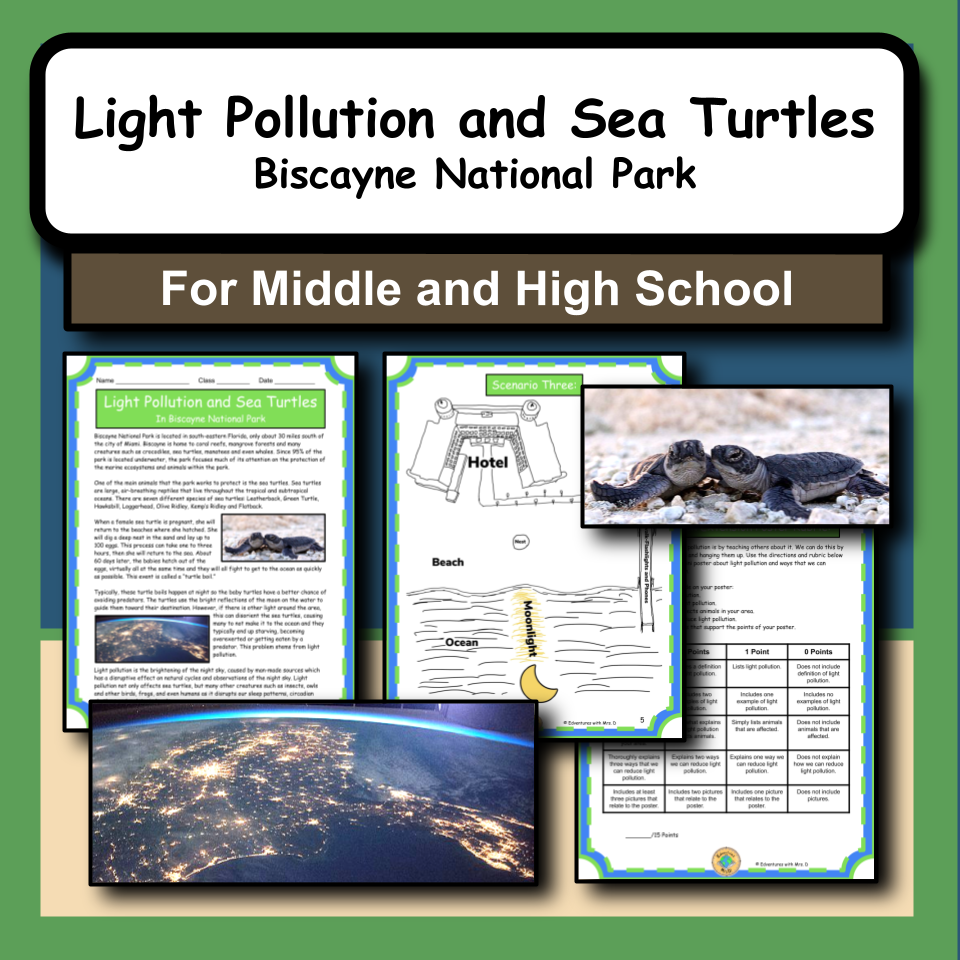
Light Pollution and Sea Turtles in Biscayne National Park Activity Packet
For Middle and High School Students
$4.00$3.00
Discover the wonders of marine conservation with our Light Pollution and Sea Turtles Educational Packet, designed for middle and high school students. Unveil the real impact of light pollution on the sea turtles of Biscayne National Park through captivating articles, interactive activities and thought-provoking scenarios. This comprehensive packet provides all the resources needed to inspire environmental awareness and empower young learners.
We are all affected by light pollution (man-made light that is lit at night). In some forms it can be good as it helps us see, but with some unnecessary bright glows comes great consequences, particularly to baby sea turtles. This activity is designed to teach this and more to middle school and high school students.
You'll begin with a short demonstration in your classroom using a flashlight and dark-colored paper to show how light pollution can affect how much we can see natural light, like stars and the moon.
Then, students will be given a six page packet. They will read about Biscayne National Park and, more specifically, about the sea turtles that they help to protect. They will read about light pollution and how it affects sea turtle babies when they get disoriented as they try to find the ocean when they’re born. They will also read about the visible light spectrum and how certain animals detect certain wavelengths of light. They will finish the reading with examples on how to improve light pollution including: keep it low, keep it long, keep it shielded.
Then, they will read three fictional scenarios about three different hotels that are located on a beach. The first hotel has a lot of light pollution, the second has some and the third has nearly none. The students will follow the provided directions to color/draw on the provided templates to represent how each of the hotel’s policies change for light pollution and how it affects the baby sea turtles on the beach.
For example, the first hotel has a lot of light pollution, so they will color in all the windows, street lamps and people on the boardwalk. Then, they will draw four sea turtles going toward the hotel lights and six going toward the ocean.
After they finish all three scenarios, they will answer ten questions about what they learned. For example, "Why is it important to understand light wavelength when it comes to light pollution?" and "What are three ways that the hotel in scenario three decreased their light pollution?"
After they finish the questions, you can choose to do the optional extension activity. Basically, students will use the provided directions and rubric to make a poster about light pollution, examples of light pollution and ways they can reduce light pollution in your area. The point is to encourage others to become more aware of light pollution.
This product includes:
Teacher Directions-materials needed
Teacher Prep Directions
Teacher Procedure
6-Page Student Packet-Reading passage, scenarios, three templates, ten analysis questions
Student Packet Answers
Scenario Answers
Teacher Tips
Optional Extension Activity Directions and Rubric
To do this activity, you will need:
Pencil
Copy of "Light Pollution" packet for each student (INCLUDED)
Optional: Flashlight (for the demonstration)
Optional: Piece of black (or dark-colored) construction paper (for the demonstration)
Optional: Tape (for the demonstration)
Coloring utensils (crayons, colored pencils, markers, etc.) Students will need red and yellow, but may want other colors for their extension posters.
Optional: Copy of Extension Activity for each student (INCLUDED)
Optional: colored paper or printer paper for the extension activity posters.
Also, check out my Youtube Channel for FREE informational videos about the national parks along with FREE video guides for your students!
Join my email list here to learn about ways to encourage students to experience the content!
You can also follow me on Pinterest, Instagram, Facebook and YouTube!
If you have any questions, feel free to email me at edventureswithmrsd@gmail.com.
Thank you!
6th-12th
Science
General Science
National Parks
Earth Science
Geography
Biology
Ecology
Environmental Science
18 Pages
"The real-life scenario and students showing their understanding by drawing the three scenarios added to student engagement as oppose to only reading and answering questions." Kaitlyn V.
